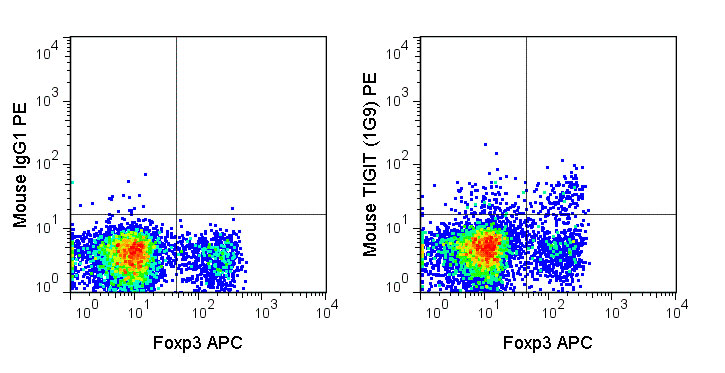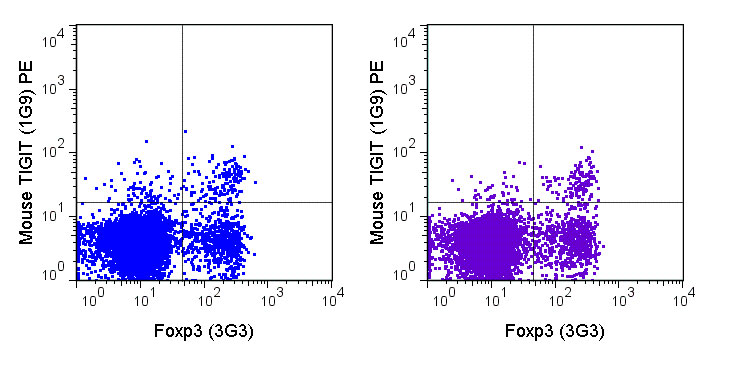PE Anti-Mouse TIGIT (1G9) Antibody
- SPECIFICATION
- CITATIONS
- PROTOCOLS
- BACKGROUND

Application
| FC |
|---|---|
| Isotype | Mouse IgG1, kappa |
| Concentration | 0.2 mg/mL |
| Reactivity | Mouse |
| Formulation | 10 mM NaH2PO4, 150 mM NaCl, 0.09% NaN3, 0.1% gelatin, pH7.2 |
| Host | Mouse |
| Gene ID | 100043314 |
|---|---|
| Alternative Name(s) | VSTM3 |
| Format | PE |
| Preparation | This monoclonal antibody was purified from tissue culture supernatant via affinity chromatography. The purified antibody was conjugated under optimal conditions, with unreacted dye removed from the preparation. It is recommended to store the product undiluted at 4°C, and protected from prolonged exposure to light. Do not freeze. |
| Application Notes | This antibody preparation has been quality-tested for flow cytometry using mouse spleen cells, or an appropriate cell type (where indicated). The amount of antibody required for optimal staining of a cell sample should be determined empirically in your system. |
| Storage Conditions | 2-8°C protected from light |
Joller N, Peters A, Anderson AC, and Kuchroo VK. 2012. Immunol. Rev. 248(1):122-139. (Flow cytometry)
Joller N, Hafler JP, Brynedal B, Kassam N, Spoerl S, Levin SD, Sharpe AH, and Kuchroo VK. 2011. J. Immunol. 186: 1338-1342. (Flow cytometry)
Provided below are standard protocols that you may find useful for product applications.
Background
The 1G9 antibody reacts with mouse TIGIT (T cell Ig and ITIM domain), a 26 kDa member of the CD28 receptor family which is reported to regulate T cell receptor (TCR) activation. Within the CD28 family of receptors there are those which have co-stimulatory activity, such as CD28 and CTLA-4, as well as more recently identified receptors like TIGIT which are proposed to provide co-inhibitory signals. TIGIT is expressed and upregulated on activated T cells, and is also expressed on memory and regulatory T cells. Upon engagement by its ligands, CD112 and CD155, TIGIT signaling inhibits T cell proliferation and suppresses T cell responses, without triggering cell deletion. A second inhibitory effect of TIGIT signaling is the generation of immunoregulatory dendritic cells, which secrete IL-10 and TGF-beta to further inhibit T cell function.
The 1G9 antibody may be used for flow cytometric analysis of TIGIT, which is expressed at very high levels on T regulatory cells (Tregs) and activated conventional T cells, as well as memory T cells and NK cells.
If you have used an Abcepta product and would like to share how it has performed, please click on the "Submit Review" button and provide the requested information. Our staff will examine and post your review and contact you if needed.
If you have any additional inquiries please email technical services at tech@abcepta.com.














 Foundational characteristics of cancer include proliferation, angiogenesis, migration, evasion of apoptosis, and cellular immortality. Find key markers for these cellular processes and antibodies to detect them.
Foundational characteristics of cancer include proliferation, angiogenesis, migration, evasion of apoptosis, and cellular immortality. Find key markers for these cellular processes and antibodies to detect them. The SUMOplot™ Analysis Program predicts and scores sumoylation sites in your protein. SUMOylation is a post-translational modification involved in various cellular processes, such as nuclear-cytosolic transport, transcriptional regulation, apoptosis, protein stability, response to stress, and progression through the cell cycle.
The SUMOplot™ Analysis Program predicts and scores sumoylation sites in your protein. SUMOylation is a post-translational modification involved in various cellular processes, such as nuclear-cytosolic transport, transcriptional regulation, apoptosis, protein stability, response to stress, and progression through the cell cycle. The Autophagy Receptor Motif Plotter predicts and scores autophagy receptor binding sites in your protein. Identifying proteins connected to this pathway is critical to understanding the role of autophagy in physiological as well as pathological processes such as development, differentiation, neurodegenerative diseases, stress, infection, and cancer.
The Autophagy Receptor Motif Plotter predicts and scores autophagy receptor binding sites in your protein. Identifying proteins connected to this pathway is critical to understanding the role of autophagy in physiological as well as pathological processes such as development, differentiation, neurodegenerative diseases, stress, infection, and cancer.



